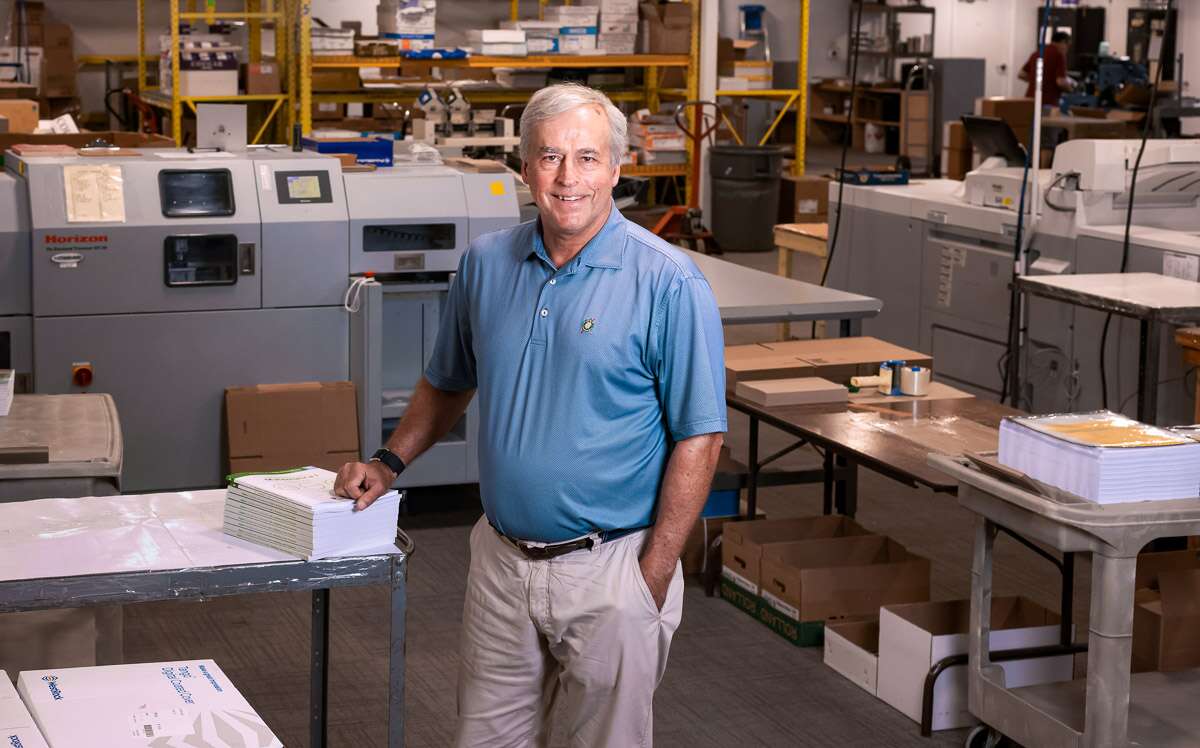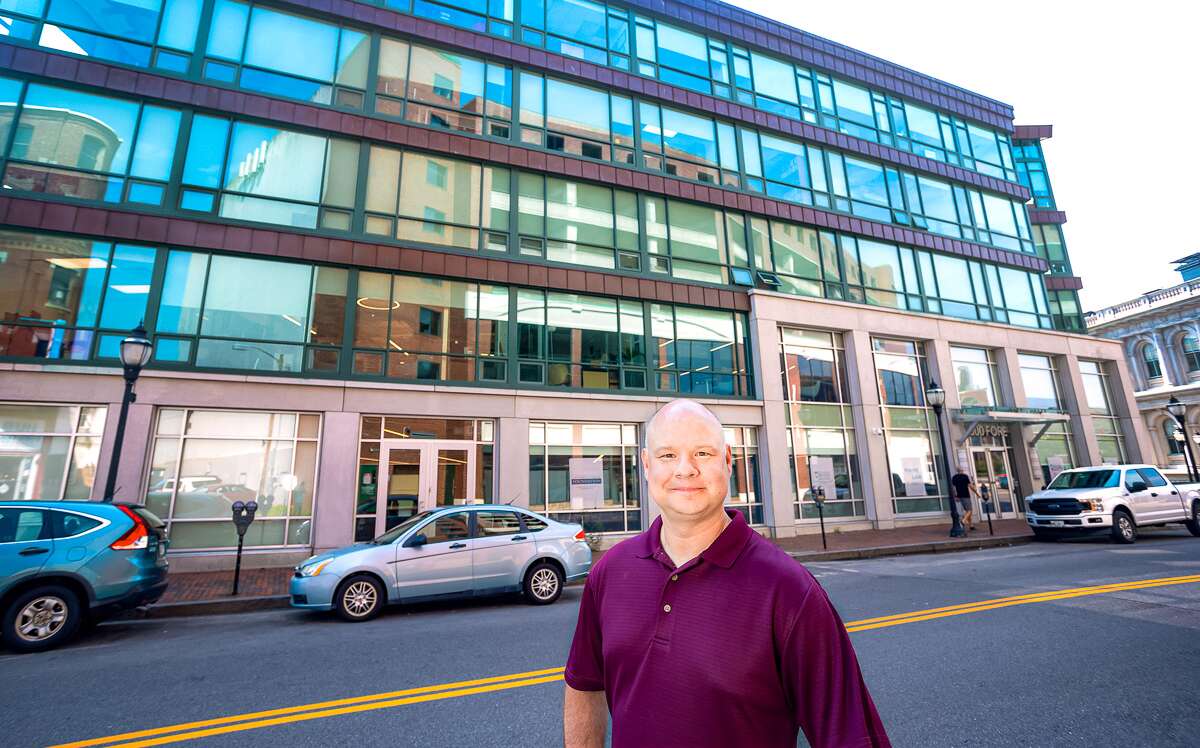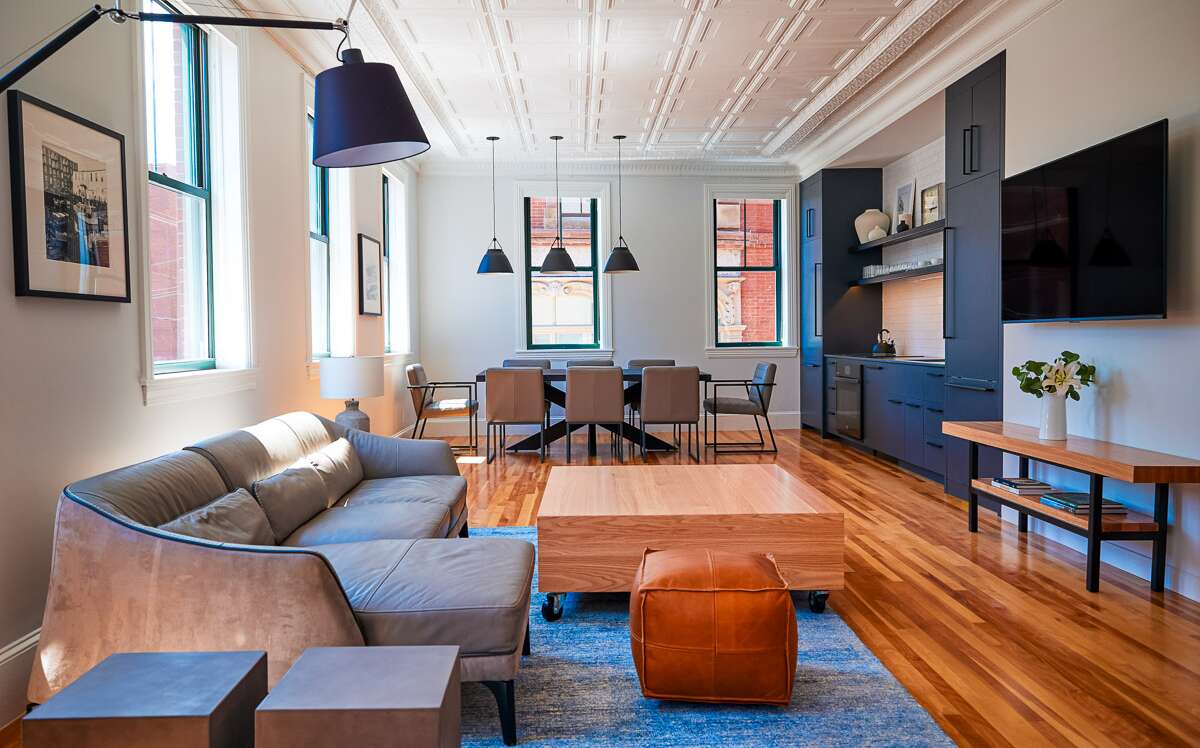
Inner space: Converting vacant offices for other uses gains traction in Maine
 Photo / Tim Greenway
Jasmin A. Moulton of Legacy Properties Sotheby’s International Realty is marketing “live-work” downtown luxury lofts for rent like this recently completed abode at 482 Congress St. in Portland. The building, which dates to 1900, still houses some offices.
Photo / Tim Greenway
Jasmin A. Moulton of Legacy Properties Sotheby’s International Realty is marketing “live-work” downtown luxury lofts for rent like this recently completed abode at 482 Congress St. in Portland. The building, which dates to 1900, still houses some offices.
A textbook printer without a loading dock for big trucks to back into? Not a problem for BW Walch at 35 Foden Road in South Portland. Last December, the company moved into the 9,000-square-foot former WEX Inc. call center.
Forced out of its former leased space in Portland, BW Walch was in a hurry to find a mixed-use facility in a tight market. The unexpected find came with climate control to keep humidity low for paper, the most important attribute for its business.
“Otherwise, all those books would be curling,” CEO and Chairman Al Noyes says as he dashes past printing machines and stacks of math and science textbooks ready to ship to school districts in Georgia, California and other places. “We could have looked for loading docks, but then climate control would have been an issue.”
Once that problem was solved, the company improvised a loading dock by punching a hole in the wall and installing an overhead door that trucks pull up to after backing in, and added an interior wall to separate offices from manufacturing. The loading set-up differs from the previous one, where vehicles could easily back in and load and unload on a level platform.

“Here, it’s less convenient, but we make do,” says Noyes. The 19-employee company also gets by without a warehouse, using Volk Paxit in Sanford as a fullment center. “We used to do it ourselves at the old place but given the urgent need to move and the configuration of the new place, Volk was a great option.”
Such is the new reality of commercial real estate as evolving work habits play out on the property market, sparking a growing number of conversions of under- or unused offices into other kinds of properties from light industrial to residential and educational.
That’s making life more interesting for brokers like Justin Lamontagne of the Dunham Group. He directed BW Walch to the Foden Road “office” listing a couple years after putting Mainely Urns into lower-level office space at 60 Pineland Drive in New Gloucester.
“Office demand was slow at that time, thus the pivot to alternative uses,” Lamontagne says. “It’s fun for us, and to some extent it gets the creative juices flowing.”
Global work shift
Around the globe, the spike in remote and hybrid work during the pandemic has cut into demand for office space.
Out of 128 business and real estate leaders worldwide surveyed by law firm DLA Piper in March, 77% said that there’s no going back to pre-pandemic office occupancy levels — almost four times as many who had that expectation last year.
Another survey, released in May by CBRE, of more than 200 corporate real estate executives, found that office space generally remains underutilized but varies by sector. While 71% of financial/professional services firms now require a return to the office, only 56% of technology companies do so, with most insisting on attendance for less than half the week.
What’s the impact on commercial real estate?
“Many investors, developers and tenants are now looking at offices the same way they used to look at regional shopping malls,” DLA Piper says in its 32-page report. “While new, Class A office buildings with significant amenities, strong ESG [environmental, social and corporate governance] may remain successful and sought-after, aging buildings could suffer in the new office paradigm.”
More than eight out of 10 respondents predicted a continuing need in 2023 to repurpose spaces and add amenities in office buildings, with one noting that “fallout from office distress is creating new opportunities for housing.”
The report also says that while the office market might not be quite as top-of mind as interest rates and inflation, it continues to significantly influence the post-pandemic outlook for commercial real estate overall.
Office market in flux
Last year in Greater Portland, both the Class A and Class B vacancy rates fell for the second straight year, for a combined rate of just 6.4%, down from 9.9% in 2020, according to a market outlook report published in December by Boulos Co. broker Nate Stevens.
Generally speaking, Class A office space is high-quality, modern buildings in prime locations with nearby amenities, and a professional look; Class B space, while still desirable, is in good locations but in older or renovated buildings.
The addition of two new downtown buildings — the Covetrus headquarters at 12 Mountfort St. and Sun Life’s new anchor at 110 Thames St. — added to the supply of Class A space in Portland in 2022. But Stevens attributes the improving Class B market to the conversion of office space to residential and hospitality uses, as well as most of those smaller buildings being occupied by local, small to medium-sized tenants that best weathered the pandemic.
“There is also considerable gray space in the Class B market, but that is likely to be offset from more significant building conversions over the next year,” he predicted in December.
Without any mid-year data to go by, Stevens nevertheless gets the sense that the direct vacancy rate has held steady over the past six to seven months, with the sublease space in downtown Portland ticking up slightly.
Empty offices are creating windows of opportunity for developers across the state. In Lewiston, Jason Levesque — mayor of neighboring Auburn who is also a developer — is converting the 65,000-square-foot Peck building that he owns from a former call center into a mix of residential and, on the lower floors, smaller workspace and retail in a rare project of its kind for the region. The city of Auburn is also marketing an empty school as a potential child care center.
Levesque says he plans to split the second and first floors into smaller spaces where demand is still decent, especially for class A, while the upper floors are ideal for residential. “With the layout of the building and its attached garage, the two uses won’t conflict,” he says.
Portland leading the way
As Maine’s largest city with the state’s greatest density of office buildings, Portland is abuzz with office redevelopment activity.
Notable projects include:
- Connecticut River Capital’s plan to transform 80,000 square feet of office space in the Fidelity Building at 465 Congress St. into 63 one- and two-bedroom apartments
- East Brown Cow’s plans to add to its Docent’s Collection of high-end, hospitality apartments in historic buildings at 178 and 184 Middle St.
- The $13.5 million revamp of an office building at 300 Fore St. into the new home of the University of Maine School of Law, the state’s only law school. The leased building, which formerly housed an international student exchange organization, opened its doors in January, after an eight-month rebuild by Consigli Construction Co.
“It was a fun challenge,” is how Consigli Project Executive Chris Brown sums up the experience, which included testing acoustics for privacy, replacing rooftop air handlers and making hallway egress changes. Then, on the day of turning over the building to the client six weeks before students were due back, a comment from Maine Law Dean Leigh Saufley caught Brown off guard.

“Chris, we have a major problem,” she said, stoking Brown’s fears of something serious like faulty walls or air handling. As it turned out, the objection was to laminate countertops, which the company easily replaced with another material.
“It was something we could handle on short notice,” says Brown, whose working relationship with Saufley dates back to her time as chief justice of Maine’s Supreme Judicial Court.
“If I’m not making clients like Leigh happy,” he says, “they’ll go elsewhere.”
Urban luxury
With the jump in hybrid and remote work sparked by the pandemic, the blurred lines between home and work are boosting demand for multi-purpose surroundings.
That’s the philosophy behind live/work luxury lofts at 482 Congress St., in a 19th-century small office building owned by brothers Timothy and Christopher Leahy since 2016.
Jasmin A. Moulton, a broker with Sotheby’s International Realty, says that two of four apartments are under lease, with another two recently finished and on the market.
“The nice thing about offices is that you have this massive space,” she says inside the larger of the two that are still empty. It’s an 1,872-square foot space with a quartz kitchen countertop, oak floors, high ceilings, large windows letting in lots of light on this sunny day, and an open-floor plan that looks like it could accommodate a dance or yoga studio.
While the $4,495 monthly rent for the two-bedroom, two-bath unit may not suit all budgets, she says that having the option to rent one space in which to live and conduct business rather than renting two spaces (residential and commercial) is an attractive alternative for small business owners.
“It’s not for everybody, but the Portland market is unique because there is such demand,” she says, predicting the office-conversion trend to continue. “With less people returning to the office, landlords have been rethinking and repurposing vacant space.”
That’s the case for Tim Soley, president and CEO of East Brown Cow, the Portland-based real estate, management and investment company behind the growing Docent’s Collection of high-end rental apartments in historic Old Port buildings that once housed offices.

“We’re restoring buildings to their 19th-century splendor with 21st-century infrastructure,” says Soley, the company’s president and CEO. When picking suitable properties, he says, “it has to be buildings that are in the middle of things and have the right geometry for hospitality.” Rectangular buildings, for example, are ideal for double corridors. One downside, however, even with historic tax credits to offset costs: “Doing high-quality construction is not cheap.”

Fork Food bulks up
In the light-industrial property niche, Fork Food Lab’s path to bigger space after outgrowing its West Bayside hub is another illustration of the real estate conversion trend.
Initially seeking a building between 10,000 and 15,000 square feet, the nonprofit shared commercial kitchen and business incubator realized by summer 2021 that it would need between 18,000 and 25,000 square feet.
In early September of that year, the team first visited a 42,000-square-foot, two-office-building property at 95-97 Darling Ave. in South Portland, part of which had been a WEX call center.
“Our first impression was, ‘too large and costly,’” says Bill Seretta, Fork Food Lab’s executive director.
As Fork’s plans evolved, the nonprofit began leasing the property from East Brown Cow in 2022 — followed by a $5.92 million purchase and sales agreement this past May. After an extensive buildout of a space that includes rooms for events and retail sales, as well as a 40-seat pop-up space to test restaurant concepts, Fork Food Lab completed the move on June 30.
Today, 50 members are working out of the enlarged Fork Food Lab, with others being brought in this summer and an additional 10 to 20 businesses expected to join this fall.
The property has undergone more than one transformation, from flexible industrial space to an office and now Fork Food Lab — with a brewing room it may later use to brew its own brand of beer.
Brice O’Connor, a broker at the Boulos Co. who advised the buyer on the purchase, predicts more deals like it in the months ahead.
“I think the conversion of office buildings to alternative users will be great for all asset classes,” keeping office vacancies down while adding needed supply for industrial and other uses, O’Connor says. “There’s a way to balance all of the sectors, it just gets down to economics and feasibility.”














0 Comments